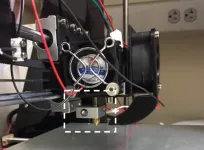INFORMATION:
Lighting it up: Fast material manipulation through a laser
2021-04-21
(Press-News.org) Making the speed of electronic technology as fast as possible is a central aim of contemporary materials research. The key components of fast computing technologies are transistors: switching devices that turn electrical currents on and off very quickly as basic steps of logic operations. In order to improve our knowledge about ideal transistor materials, physicists are constantly trying to determine new methods to accomplish such extremely fast switches. Researchers from the Fritz Haber Institute of the Max Planck Society in Berlin and the Max Planck Institute for the Structure and Dynamics of Matter in Hamburg have now figured out that a novel type of ultrafast switch can be accomplished with light.
The physicists involved in the project are studying how to best get materials to change their properties - to make magnetic metals non-magnetic, for example, or to change the electric conductivity of a crystal. A material's electrical properties are strongly related to the arrangement of the electrons in the crystal. Controlling the electrons' arrangement has been a key topic for decades. Most control methods, however, are fairly slow. "We knew that external influences like temperature or pressure variations work", says Dr. Ralph Ernstorfer, Group Leader at the Department of Physical Chemistry at the Fritz Haber Institute, "but that takes time, at least a few seconds." Those who regularly use a smart phone or computer know that a few seconds can feel like eternity. So Dr. Ernstorfer's group explored how to switch material properties much faster by means of light.
Using brand new equipment at the Fritz Haber Institute, the researchers have massively cut down the switching time to only 100 femtoseconds - 0,000 000 000 000 1 of a second - by shooting ultrashort optical laser pulses at their chosen material, a semi-metallic crystal composed of tungsten and tellurium atoms. Shining light on the crystal encourages it to re-organize its internal electronic structure, which also changes the conductivity of the crystal. In addition, the scientists were able to observe exactly how its electronic structure changed. "We used a new instrument to take pictures of the transition every step of the way", explains Dr. Samuel Beaulieu, who worked as a postdoctoral fellow with Ralph Ernstorfer at the Fritz-Haber-Institut (2018-2020) and who is now a permanent researcher at the Centre Lasers Intenses et Applications (CELIA) at CNRS-Bordeaux University. "This is amazing progress - we used to only know what the electronic structure of the material looked like after, but never during the transition," he adds. Moreover, state-of-the-art modeling of this new process by Dr. Nicolas Tancogne-Dejean, Dr. Michael Sentef, and Prof. Dr. Angel Rubio from Max the Planck Institute for the Structure and Dynamics of Matter has revealed the origin of this novel type of ultrafast electronic transition. The laser pulse impinging on the materials changes the way electrons interact with each other. That is the driving force of this exotic transition, known as a Lifshitz transition.
This method is bound to generate a great deal of knowledge about possible future transistor materials. The fact alone that light can drive ultrafast electronic transitions is a first step towards even quicker and more efficient technology.
ELSE PRESS RELEASES FROM THIS DATE:
What leads young women to disclose abuse in their first relationships?
2021-04-21
Women who experience partner violence at a young age don't always show physical signs of abuse and don't always disclose -- or recognize -- the dangerous position they're in. A new study from Michigan State University is one of the first to examine multiple factors that influence young women's disclosure of partner violence that occurred during their first relationships, when they were just under 15 years old, on average.
"Physical abuse is widely understood as unhealthy, wrong and abusive, but sexual violence and coercive control are less understood and still pretty hidden, especially among young women," said Angie C. Kennedy, MSU associate professor of ...
Verbal fluency deficits in multiple sclerosis may reflect impaired language ability
2021-04-21
East Hanover, NJ. April 21, 2021. Kessler Foundation researchers showed that people with multiple sclerosis (MS) experience subtle language impairments that standard neuropsychological tests may incorrectly attribute to impaired executive functions. The article, "The role of language ability in verbal fluency of individuals with multiple sclerosis" (doi: 10.1016/j.msard.2021.102846) was published on February 16, 2021, in Multiple Sclerosis and Related Disorders.
The authors are Nancy D. Chiaravalloti, PhD, director of the Centers for Neuropsychology, Neuroscience, and Traumatic Brain Injury Research at Kessler Foundation, Lauren B. Strober, PhD, senior research scientist at the Center for Neuropsychology and Neuroscience ...
Record-breaking flare from Sun's nearest neighbor
2021-04-21
Washington, DC-- A team of astronomers including Carnegie's Alycia Weinberger and former-Carnegie postdoc Meredith MacGregor, now an assistant professor at the University of Colorado Boulder, spotted an extreme outburst, or flare, from the Sun's nearest neighbor--the star Proxima Centauri.
Their work, which could help guide the search for life beyond our Solar System, is published in The Astrophysical Journal Letters.
Proxima Centauri is a "red dwarf" with about one-eighth the mass of our Sun, which sits just four light-years, or almost 25 trillion miles, from the center of our Solar System and hosts at least two planets, one of which may look something like Earth.
In a worldwide campaign carried out ...
Does listening to calming music at bedtime actually help you sleep?
2021-04-21
A new study published in the Journal of the American Geriatrics Society has found that listening to music can help older adults sleep better.
Researchers from the National Cheng Kung University Hospital in Taiwan combined the results of past studies to understand the effect that listening to music can have on the quality of older adults' sleep. Their work suggests that:
- Older adults (ages 60 and up) living at home sleep better when they listen to music for 30 minutes to one hour at bedtime.
- Calm music improves older adults' sleep quality better than rhythmic music does.
- ...
Study: 'Fingerprint' for 3D printer accurate 92% of time
2021-04-21
BUFFALO, N.Y. - 3D printing is transforming everything from fashion and health care to transportation and toys. But this rapidly evolving technology, also known as additive manufacturing, can threaten national security and intellectual property rights.
To reduce illicit use of 3D printers, Zhanpeng Jin, PhD, associate professor in the Department of Computer Science and Engineering at the University at Buffalo, is developing a way to track the origin of 3D-printed items.
His concern was that, as long as people have the digital design for an item, which can be downloaded from the internet, sometimes as open-source material, people can print out anything they want, which can range from computer parts and toys to fully functional handguns and assault rifles.
"So, ...
A growing problem of 'deepfake geography': How AI falsifies satellite images
2021-04-21
A fire in Central Park seems to appear as a smoke plume and a line of flames in a satellite image. Colorful lights on Diwali night in India, seen from space, seem to show widespread fireworks activity.
Both images exemplify what a new University of Washington-led study calls "location spoofing." The photos -- created by different people, for different purposes -- are fake but look like genuine images of real places. And with the more sophisticated AI technologies available today, researchers warn that such "deepfake geography" could become a growing problem.
So, using satellite photos of ...
A "finger phantom" to train treatment of trigger finger using ultrasound guidance
2021-04-21
BIRMINGHAM, Ala. - Treatment of an injured or diseased joint may require precise insertion of a syringe needle -- musculoskeletal sonography can help guide clinicians as they drain fluid from arthritic knees or inject corticosteroids into trigger fingers. However, there is a need for training simulators that allow practice on an inert model, before attempting treatment on a patient.
For ultrasound, such simulation trainers are called phantoms.
Researchers at the University of Alabama at Birmingham and University of South Carolina have now made a 3D-printed ...
Aerial photos uncover an invisible fault in Chinese City
2021-04-21
Decades-old aerial photos of Yudong District, Datong City in Shanxi Province, Northern China have helped researchers in their search for a fault hidden underneath the city's buildings and cement roads, researchers said at the Seismological Society of America (SSA)'s 2021 Annual Meeting.
Analyzing these photos from the 1960s and 1970s allowed Junjie Ren and colleagues to reconstruct a digital elevation model along the Shuiyu fault, helping them identify the fault trace as it passes through Datong City.
Trenching along the revealed fault trace found evidence of ...
Researchers share strategies for making geosciences more inclusive
2021-04-21
Concrete efforts to bring racial equity to the geosciences are receiving significant attention in the wake of new grassroots efforts and increased awareness of social justice issues in 2020, speakers said at the Seismological Society of America (SSA)'s 2021 Annual Meeting.
Last year's Black in Geoscience Week, for instance, began as a grassroots movement to increase representation and raise visibility among Black researchers, as well as to foster networks and connections across the world, said Louisa Brotherson, a leader of the Black in Geoscience group.
The need for community and awareness ...
Pepper the robot talks to itself to improve its interactions with people
2021-04-21
Ever wondered why your virtual home assistant doesn't understand your questions? Or why your navigation app took you on the side street instead of the highway? In a study published April 21st in the journal iScience, Italian researchers designed a robot that "thinks out loud" so that users can hear its thought process and better understand the robot's motivations and decisions.
"If you were able to hear what the robots are thinking, then the robot might be more trustworthy," says co-author Antonio Chella, describing first author Arianna Pipitone's idea that launched the study at the University of Palermo. "The robots will be easier to understand for ...






